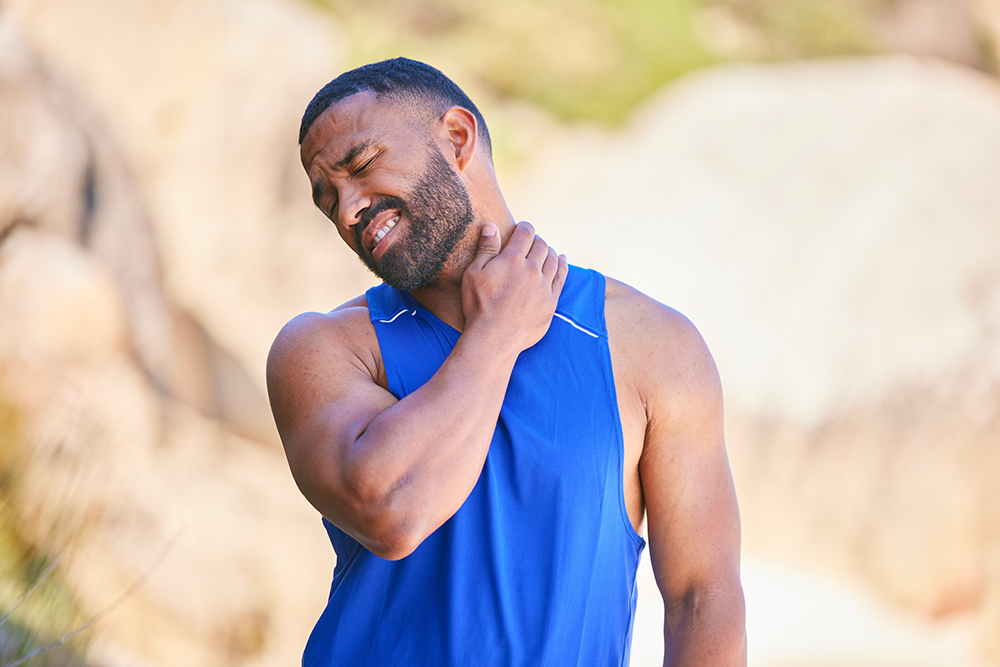Contents
Having trouble with neck pain? Finding an effective pain relief method is important. Neck pain can be a constant source of discomfort, impacting your daily activities and overall quality of life. Left untreated, neck pain often gets worse and leads to other symptoms. When addressing pain in the neck, early intervention is key.
If you are looking for a good solution to your neck pain, physical therapy can be a great option. Physical therapy involves a range of techniques and special modalities designed to alleviate pain and other symptoms causing discomfort. A core aspect of PT for neck pain is targeted exercise. Your physical therapist can work with you to develop an exercise regimen that matches your needs and recovery goals. Learning more about the best PT exercises can help you prepare for treatment.
Top PT exercises for neck pain relief
- Neck tilts — Neck tilts are a great quick, simple exercise to help relieve neck pain. To start, tilt your head gently and slowly to one side. You should feel the stretch on the other side of your neck. Hold for around 15 seconds; then switch sides. Depending on your condition, your physical therapist may recommend doing five to 10 repetitions per side.
- Flexion and extension — Flexion and extension exercises can be a good way to improve your neck’s flexibility and eliminate muscle tension. Flexing and extending the neck engages some of the most important muscles in the area. One of the best ways to flex and extend your neck is an exercise that looks like a controlled nodding motion. Start by lowering your chin until you feel a stretch in the back of your neck. Then lift your chin upward and try to look toward the ceiling. Now you should feel a stretch in the front part of your neck. After looking up, relax for a few seconds before repeating the exercise again.
- Shoulder blade squeezes — Your neck is deeply interconnected with your shoulders. In many cases, neck pain is actually rooted in an injury or other condition affecting the shoulders. Working out your shoulders can potentially address neck pain and improve overall spinal health. One good way to exercise your shoulders is through shoulder blade squeezes. To do this exercise, begin by straightening out your spine. Next, squeeze your shoulder blades together. You may feel the stretch around the center of your chest as well as in your shoulder blades. Hold the stretch for around 10 seconds; then relax and repeat.
Physical therapy exercises for a herniated disc in the neck
A herniated disc occurs when the soft core of a spinal disc pushes through its tough shell-like casing. This typically happens as a result of pressure on the vertebrae, which are the spinal bones connected by the discs. If you have a herniated disc, it is important to seek treatment. As part of your treatment plan, your physical therapist may recommend neck exercises like these:
- Neck retraction — Neck retraction, or chin tuck, is the motion of bringing your head backward without tilting it. As you move your head back, try not to look up. You may feel your chin pressing against your upper neck. If having a visual helps, imagine you are trying to make a double chin. Once your neck is retracted, hold for around 10 seconds and then repeat. Neck retractions can be a great way to improve your posture and keep your spine aligned.
- Cervical traction — Cervical traction involves gently pulling your head away from your shoulders. This kind of stretch can help loosen up neck muscles and alleviate pain. There are a few different cervical traction techniques. Some involve hands-on assistance from a physical therapist; others can be accomplished solo. One way to perform a cervical traction stretch on your own is with a pillow or rolled-up towel. Start by lying on your back with the pillow or towel on the front of your neck. Then nod your head forward. You should feel a stretch throughout your neck. Try to hold for 15 to 20 seconds before lying back down and repeating.
- Neck flexion — To do neck flexion exercise, start by sitting or standing with your spine as straight as possible. Gently tilt your chin down toward your chest. You should feel a stretch in the back of your neck. Your physical therapist may recommend modifying this exercise by adding resistance with your hand. To do this, put one hand on your chin and apply light resistance as you tilt your neck down. This exercise can help strengthen your neck and alleviate disc pain.
Physical therapy exercises for neck arthritis
Arthritis refers to a set of conditions that involve joint inflammation. Osteoarthritis and rheumatoid arthritis are two of the most common kinds of arthritis. Arthritis can affect joints in many regions throughout the body including the neck. If you have arthritis of the neck, you may experience symptoms such as neck pain and chronic stiffness. Here are some specialized exercises your physical therapist may recommend to manage your condition:
- Upper trapezius stretch — To do upper trapezius stretches, start by sitting in a comfortable but firm chair. Sit upright while keeping your shoulders a bit low. With one arm, reach for the underside of your seat. This should make the shoulder of that arm even lower. Next, tilt your head to the side and try to bring your ear to the lower shoulder. You should feel a stretch on the upper side of the opposite shoulder as well as your neck. After holding the stretch for a few seconds, you can release and switch sides. This exercise engages the upper part of the trapezius, an important muscle situated around the upper part of your spine. Improving the strength and flexibility of this muscle can help alleviate your symptoms.
- Head drop — To do head drops, start in a sitting or standing position. When you are ready to start, slowly lower your head toward your chest. In some ways, head drops are similar to neck flexion exercises. The biggest difference is that instead of tucking your chin, you should let it rest around your upper chest. You should feel a stretch in the front and back of your neck. In addition to improving flexibility, this exercise can help improve blood flow and reduce your pain levels.
- Neck rotations — Neck rotations are a great way to exercise the sides of your neck. Building strength in the sides of your neck can help your joints get more support, which can lead to a reduction in your arthritis pain. To do neck rotations, slowly turn your head to the left. Try to keep your head from tilting up or down as you turn. As you turn your head to the left, you should feel a stretch in the right side of your neck. After feeling the stretch, you can reset and rotate your neck in the other direction. A few repetitions each day can lead to major improvement over time.
Address your neck pain and discomfort with help from Lattimore Physical Therapy
Lattimore Physical Therapy can help you find effective solutions for your neck pain. Exercises can be an integral part of the recovery process, but it is not usually the only form of treatment. Combining various treatment methods can be crucial to making a successful recovery. By integrating multiple forms of PT, you can experience optimal results. Our approach involves targeted exercises synergized with other highly effective treatments for lasting pain relief. With a comprehensive treatment plan, our team can help you alleviate your symptoms and improve your neck health.
Contact our team today for more information or to schedule an initial appointment.


